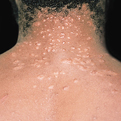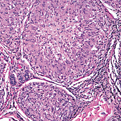Sarcoidosis
General Information
Sarcoidosis is an inflammatory disease that usually begins in the lungs but with time can affect any organ in the body. Cutaneous involvement occurs with about 25% of patients, usually accompanying systemic involvement but may be the only site of involvement. When the skin is involved, it is either classified as specific or nonspecific involvement. Erythema nodosum, characterized by red bumps that occur primarily on the shins, is the main nonspecific cutaneous disease. Lupus pernio, maculopapular, nodular, scar, plaque, angiolupoid, ichthyosiform, lichenoid, psoriasiform, ulcerative lesions and subcutaneous nodules are examples of specific cutaneous disease. If sarcoidosis is only affecting the lungs and nearby lymph nodes, treatment is not necessary, a healthcare provider is likely to monitor the patient closely. If the heart, eyes, nervous system is involved, or blood calcium level is elevated treatment with powerful anti-inflammatory drugs are usually recommended.
Epidemiology
1-40 cases per 100,000 of the population in the United States
Etiology
Unknown; Genetics and environmental factors are thought to play a role
Pathogenesis
Noncaseating epithelioid granulomas that may affect any organ system
Clinical
Papules consisting of discrete collections of epithelioid histiocytes
Histology
Circumscribed granulomas of epithelioid cells with little or no necrosis
Bibliography
1. “Sarcoidosis” (Online). July 2006. http://www.mayoclinic.com/health/sarcoidosis/DS00251/DSECTION=1 (visited: April 3, 2008) 2. “Sarcoidosis” (Online). February 2006. http://www.emedicine.com/derm/TOPIC381_ORIG.HTM#section~clinical (visited: April 3, 2008)
Download PDF
![]() Sarcoidosis
Sarcoidosis


